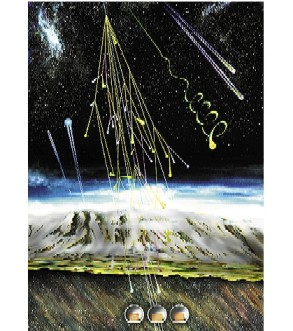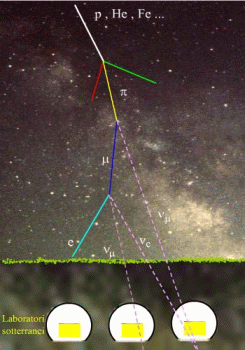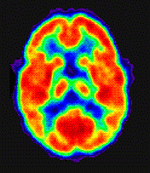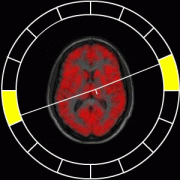Antimatter around us
The concept of antimatter was so revolutionary that it had to wait for experimental confirmation before being accepted.
Antimatter is now used every day in medicine to
analyze our brain with the Positron Emission Tomography technique (PET). It
allows us to measure the metabolic functions and the biochemical reactions in the brain; it has many
applications in neurosciences, oncology and cardiology.
For the PET,
positrons![]() come from the decay of
radioactive nuclei
come from the decay of
radioactive nuclei![]() , incorporated in a special
fluid injected into a patient. The emitted positrons
annihilate
, incorporated in a special
fluid injected into a patient. The emitted positrons
annihilate![]() with the electrons
with the electrons![]() of the
atoms
of the
atoms![]() in the brain and give rise to two
gamma rays
in the brain and give rise to two
gamma rays![]() emitted in
opposite directions. These are observed using special
detectors
emitted in
opposite directions. These are observed using special
detectors![]() which surround the
head of the patient; they find the point where the annihilation took place: PET
allows us to reconstruct the exact locations where the radioactive medicine was
distributed.
which surround the
head of the patient; they find the point where the annihilation took place: PET
allows us to reconstruct the exact locations where the radioactive medicine was
distributed.
|
|
|
Cosmic ray![]() particles come from outer space, from all
directions. They are mainly composed of high energy
protons
particles come from outer space, from all
directions. They are mainly composed of high energy
protons![]() and helium nuclei,
and of some heavier nuclei. When they reach the top of the earth's atmosphere
they interact with the nitrogen and oxygen
nuclei
and helium nuclei,
and of some heavier nuclei. When they reach the top of the earth's atmosphere
they interact with the nitrogen and oxygen
nuclei![]() of the air, producing new
particles and antiparticles, transforming their kinetic energy into the mass of
the created particles. Cosmic rays are thus a source of some antiparticles and
in 1932
Carl
Anderson detected the first antiparticle: the positron.
of the air, producing new
particles and antiparticles, transforming their kinetic energy into the mass of
the created particles. Cosmic rays are thus a source of some antiparticles and
in 1932
Carl
Anderson detected the first antiparticle: the positron.
 Fig. 2: A cosmic ray interacts in the high atmosphere yielding a cascade of new particles and antiparticles. (Credit: INFN-Notizie N.6 April 2001 "Dai raggi cosmici all'universo") |
 Fig. 3: Interaction of a cosmic ray particle in the atmosphere. Click on the picture to see the animation. (If you don't see the animation, you need to install Flash Player [here]). (Credit: Davide Centomo, Dep. of Physics University of Bologna) |

